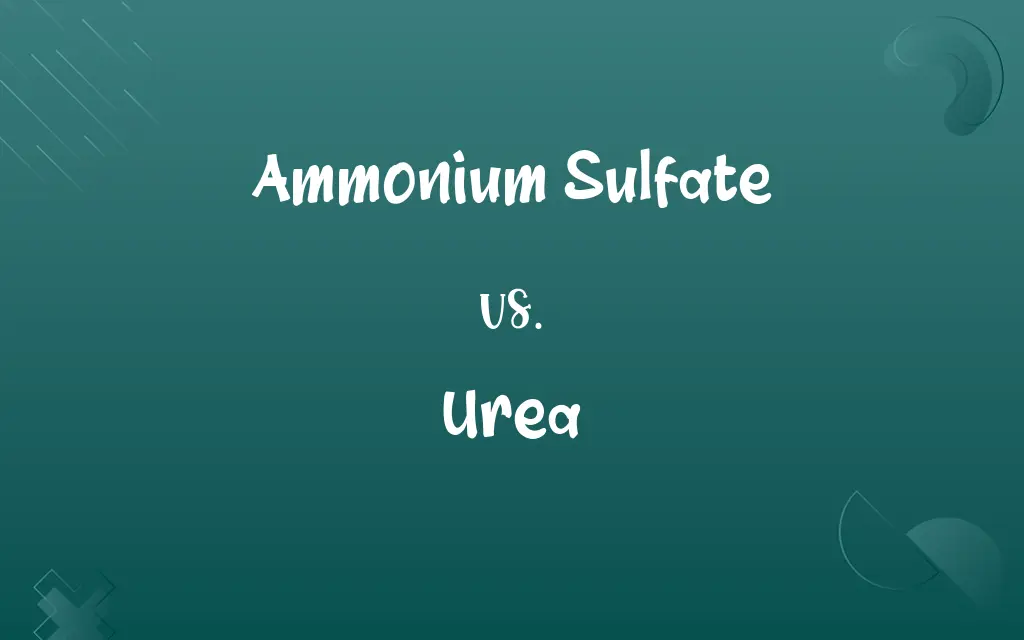Ammonium Sulfate vs. Urea: Know the Difference

By Shumaila Saeed || Updated on December 25, 2023
Ammonium Sulfate is an inorganic salt used as a fertilizer, while Urea is an organic compound used in agriculture and industry.

Key Differences
Ammonium Sulfate, a chemical compound with the formula (NH4)2SO4, is widely used as a soil fertilizer providing nitrogen and sulfur. Urea, on the other hand, is an organic compound with the formula CO(NH2)2, primarily used as a nitrogen-release fertilizer. Both are essential in agriculture but differ in composition and nitrogen content.
Shumaila Saeed
Dec 18, 2023
In the agricultural context, Ammonium Sulfate is known for its quick-release of sulfur, benefiting crops in sulfur-deficient soils. Urea, recognized for its high nitrogen content, is preferred for its cost-effectiveness and ease of handling. Both fertilizers play crucial roles but cater to different nutrient requirements of plants.
Shumaila Saeed
Dec 18, 2023
Ammonium Sulfate is less prone to volatilization compared to Urea, making it a more stable nitrogen source in certain conditions. Urea, however, is more concentrated in nitrogen, making it a more efficient choice in terms of transport and storage. Both serve distinct agronomic purposes.
Shumaila Saeed
Dec 18, 2023
Environmentally, Ammonium Sulfate can contribute to soil acidification over time, requiring careful management. Urea, while having a lower acidifying effect, can lead to ammonia volatilization if not properly applied. Both have environmental implications that need consideration in agricultural practices.
Shumaila Saeed
Dec 18, 2023
In terms of solubility, Ammonium Sulfate dissolves readily in water, making it suitable for various application methods. Urea boasts even greater solubility, which is advantageous for foliar sprays and irrigation systems. Both offer versatility in application but with different solubility characteristics.
Shumaila Saeed
Dec 18, 2023
ADVERTISEMENT
Comparison Chart
ADVERTISEMENT
Ammonium Sulfate and Urea Definitions
Ammonium Sulfate
A laboratory reagent.
Ammonium sulfate was used in the precipitation of proteins.
Shumaila Saeed
Dec 11, 2023
Ammonium Sulfate
A compound in fire extinguishers.
Ammonium sulfate is effective in certain types of fire extinguishers.
Shumaila Saeed
Dec 11, 2023
Urea
A component in animal feed.
Urea is added to cattle feed to boost protein intake.
Shumaila Saeed
Dec 11, 2023
Ammonium Sulfate
A water treatment chemical.
They added ammonium sulfate to purify the water.
Shumaila Saeed
Dec 11, 2023
ADVERTISEMENT
Urea
A raw material in plastics.
Urea is a key component in some plastic manufacturing processes.
Shumaila Saeed
Dec 11, 2023
Ammonium Sulfate
A food additive.
Ammonium sulfate is sometimes added to bread to regulate acidity.
Shumaila Saeed
Dec 11, 2023
Urea
A nitrogen-rich fertilizer.
Urea is commonly used to enhance plant growth.
Shumaila Saeed
Dec 11, 2023
Ammonium Sulfate
A salt used in fertilizers.
The farmer used ammonium sulfate to enrich his soil.
Shumaila Saeed
Dec 11, 2023
Urea
A medical diagnostic agent.
Urea breath tests help diagnose stomach bacteria.
Shumaila Saeed
Dec 11, 2023
Urea
A water-soluble compound, CO(NH2)2, that is the major nitrogenous end product of protein metabolism and is the chief nitrogenous component of the urine in mammals and certain other animals. Also called carbamide.
Shumaila Saeed
Dec 10, 2023
Urea
A water-soluble organic compound, CO(NH2)2, formed by the metabolism of proteins and excreted in the urine.
Shumaila Saeed
Dec 10, 2023
Urea
Any N-substituted derivative of urea, with the general formula (R1R2N)CO(NR3R4).
Shumaila Saeed
Dec 10, 2023
Urea
A very soluble crystalline body which is the chief constituent of the urine in mammals and some other animals. It is also present in small quantity in blood, serous fluids, lymph, the liver, etc.
Shumaila Saeed
Dec 10, 2023
Urea
The chief solid component of mammalian urine; synthesized from ammonia and carbon dioxide and used as fertilizer and in animal feed and in plastics
Shumaila Saeed
Dec 10, 2023
Repeatedly Asked Queries
What is Urea mainly used for?
Urea is used as a fertilizer, in plastics, and in medical diagnostics.
Shumaila Saeed
Dec 18, 2023
What is Ammonium Sulfate used for?
It's primarily used as a fertilizer and in certain industrial processes.
Shumaila Saeed
Dec 18, 2023
Does Urea have medical uses?
Yes, it's used in medical diagnostics, such as in urea breath tests.
Shumaila Saeed
Dec 18, 2023
What nutrients does Ammonium Sulfate provide to plants?
It provides nitrogen and sulfur.
Shumaila Saeed
Dec 18, 2023
Can Ammonium Sulfate be used in fire extinguishers?
Yes, it's used in certain types of fire extinguishers.
Shumaila Saeed
Dec 18, 2023
Can Ammonium Sulfate be used in food?
Yes, it's used as a food additive, especially in bread.
Shumaila Saeed
Dec 18, 2023
Does Ammonium Sulfate affect soil pH?
Yes, it can contribute to soil acidification.
Shumaila Saeed
Dec 18, 2023
How is Urea typically applied in agriculture?
It can be applied as granules or dissolved in water for irrigation.
Shumaila Saeed
Dec 18, 2023
Does Urea have a role in plastic manufacturing?
Yes, it's a raw material in certain plastics.
Shumaila Saeed
Dec 18, 2023
What precautions should be taken when using Urea?
It should be applied correctly to avoid environmental harm, like ammonia release.
Shumaila Saeed
Dec 18, 2023
What industries use Ammonium Sulfate?
Agriculture, water treatment, and food industries.
Shumaila Saeed
Dec 18, 2023
Can Ammonium Sulfate be used in water treatment?
Yes, it's used in some water purification processes.
Shumaila Saeed
Dec 18, 2023
Are there any safety concerns with Ammonium Sulfate?
It's generally safe, but precautions are needed when handling large quantities.
Shumaila Saeed
Dec 18, 2023
Is Urea harmful to the environment?
It can lead to ammonia volatilization if not applied correctly.
Shumaila Saeed
Dec 18, 2023
Share this page
Link for your blog / website
HTML
Link to share via messenger
About Author
Written by
Shumaila SaeedShumaila Saeed, an expert content creator with 6 years of experience, specializes in distilling complex topics into easily digestible comparisons, shining a light on the nuances that both inform and educate readers with clarity and accuracy.









































































